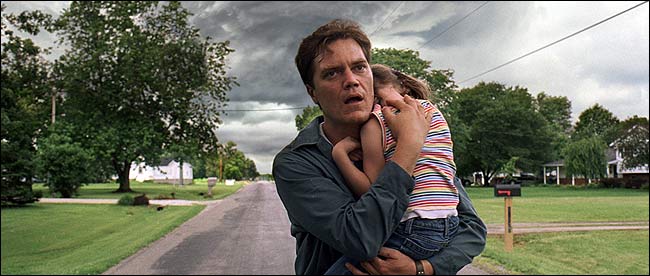

The Oncoming Storm
Seek refuge in Take Shelter
TAKE SHELTER: Written and directed by Jeff Nichols. Cinematography, Adam Stone. Editor, Parke Gregg. Music, David Wingo. Starring Michael Shannon and Jessica Chastain. Sony Pictures Classics, 2011. R. 120 minutes. Four stars.
When Zombieland came out, a friend told me, “You have to see it. But if I tell you why you have to see it, I’ll ruin it.” He was mellow enough about the comment that it piqued my interest without making me spend the entire movie wondering, Was that it? Was that? What was it he couldn’t tell me about?
Take Shelter likewise has a thing, though that thing isn’t what makes the movie worth seeing. There are plenty of reasons to see Take Shelter without this cryptic — but relevant — comparison hanging over the film, which starts so quietly that you may find yourself wondering what all the buzz is about. With his slightly protuberant eyes and a mouth that seems to want to consume itself, Michael Shannon has a compelling, intense presence as Curtis, a thirtysomething husband and father whose life runs in worn, lived-in rhythms. Mornings begin at the breakfast table with Curtis’ wife, Samantha (Jessica Chastain), and their daughter, Hannah (Tova Stewart). Curtis trucks off to his construction job; Samantha stays home with Hannah or sells her sewing at an outdoor market. She has friends, family, church, hobbies and the matter of getting their health insurance to pay for a cochlear implant for Hannah, who is deaf.
Curtis has visions. Or hallucinations, or delusions. Maybe they’re just dreams. Creepy and effective, the dreams begin with a storm and end with Curtis shaken and exhausted. The uncertainty and fear created by Curtis’ visions are so effective that halfway through the film, I was anxious for them to stop, for the pattern to change and the tension to break.
Instead, it builds, like humidity and the spark in the air before a storm. All Take Shelter’s pieces snap into place neatly, and if an occasional subplot point is a bit too clearly telegraphed, it’s easy enough to overlook that in favor of the film’s many strengths: the acting (this is the least showy and most affecting of Chastain’s roles so far this year); the colors and light of Ohio summer; the taut way Nichols builds Curtis’ fears. Any excess has been pared away from the story, leaving meaning neatly packed into telling details, like a minor character’s sideways glance or the set of a woman’s jaw.
Curtis, wanting the dreams to stop, sees a doctor and a counselor. Nicholas carefully avoids anything like a recognizable diagnosis or an easy answer. More often than not, Take Shelter is a sympathetic portrait of a man losing his grip, irreparably rattled by terror and images of a world he can’t control. The fear is specific yet broad, and permeates the lives of those around Curtis in more ordinary ways. Economic disaster hovers nearby, and vacation money accumulates not in a bank account but in a decorative tin. Things are safer closer to home.
Much more than that, I’m reluctant to say. Take Shelter is beautifully structured, and part of that structure pulls the teeth from any discussion that wants to avoid spoilers. Writing about a story is always a tricky dance of saying enough but not too much. In some cases you just skip the plot entirely, but Nichols twines plot to character with a cleverly knotted rope. Pull one end, and the whole thing unspools in an abrupt reveal. There are things you just shouldn’t know before you see this unsettling film. Anxiety about the future, whether it’s one of disaster for the world or dismay for Curtis, seeps into every image, from the rubble of a construction site to the dingy cots of a storm shelter. If you look past the striking craftsmanship of the film, there’s a little girl in the middle of it, embodying a familiar question: What kind of future are we expecting? And what happens when it gets here?